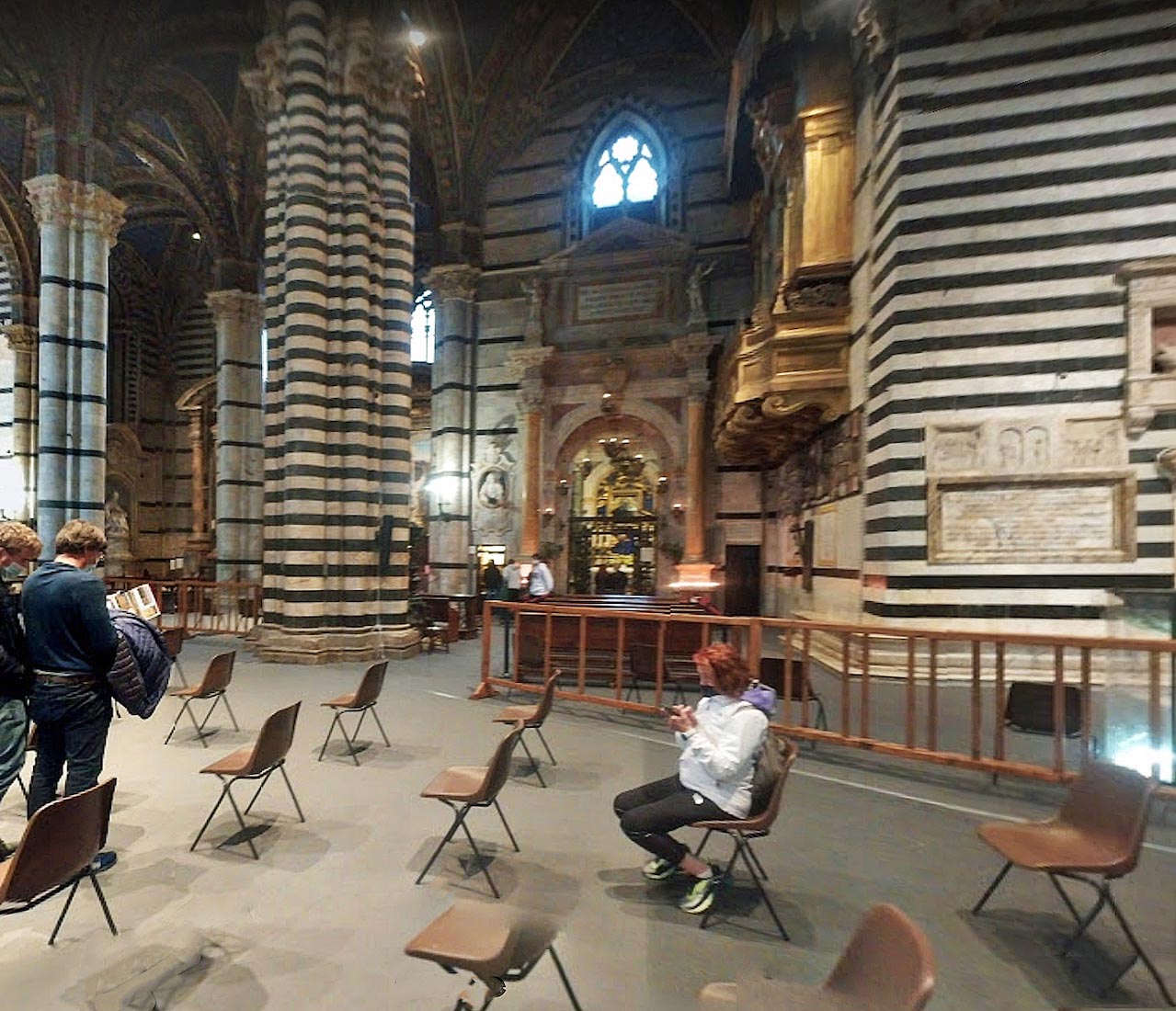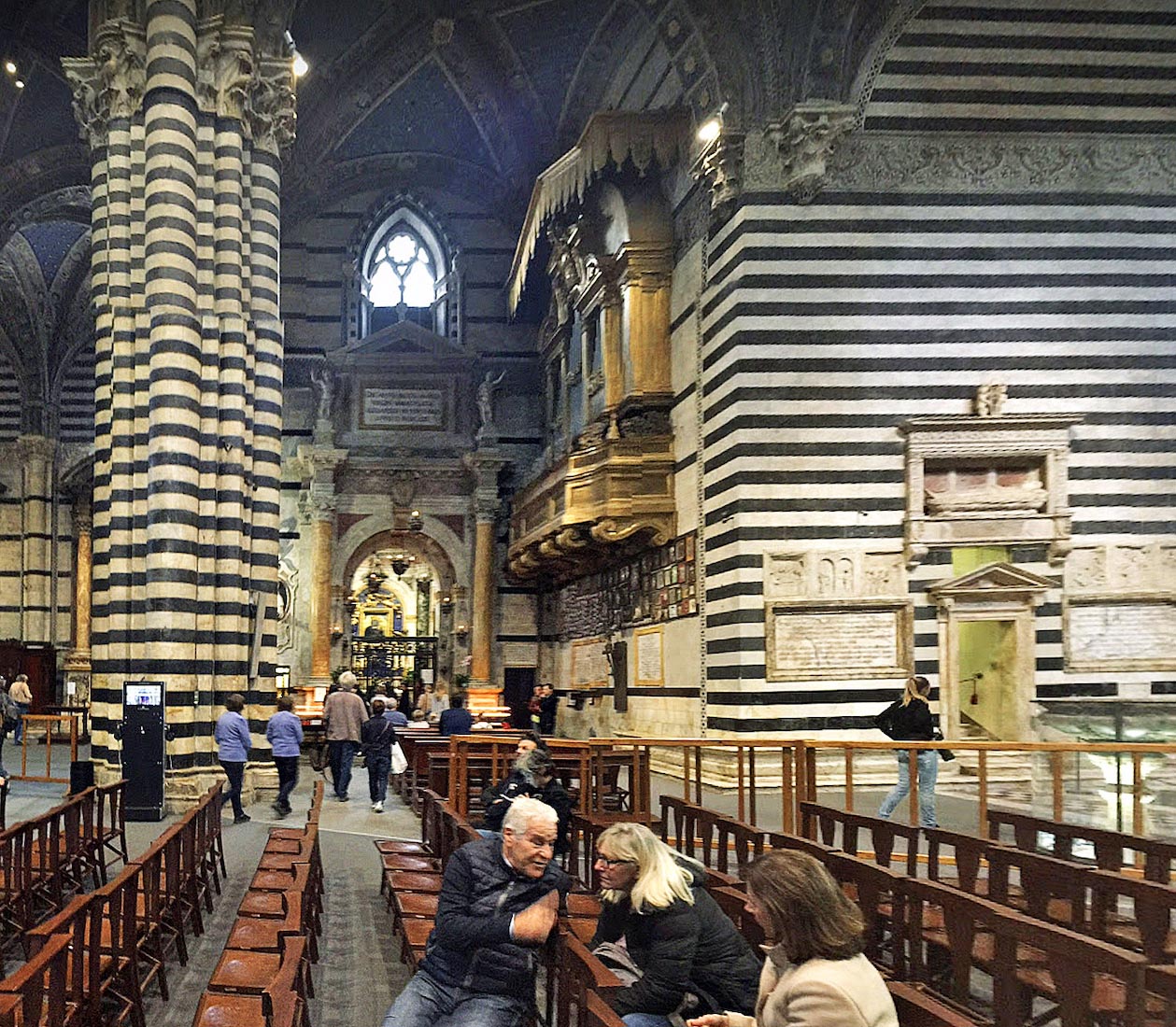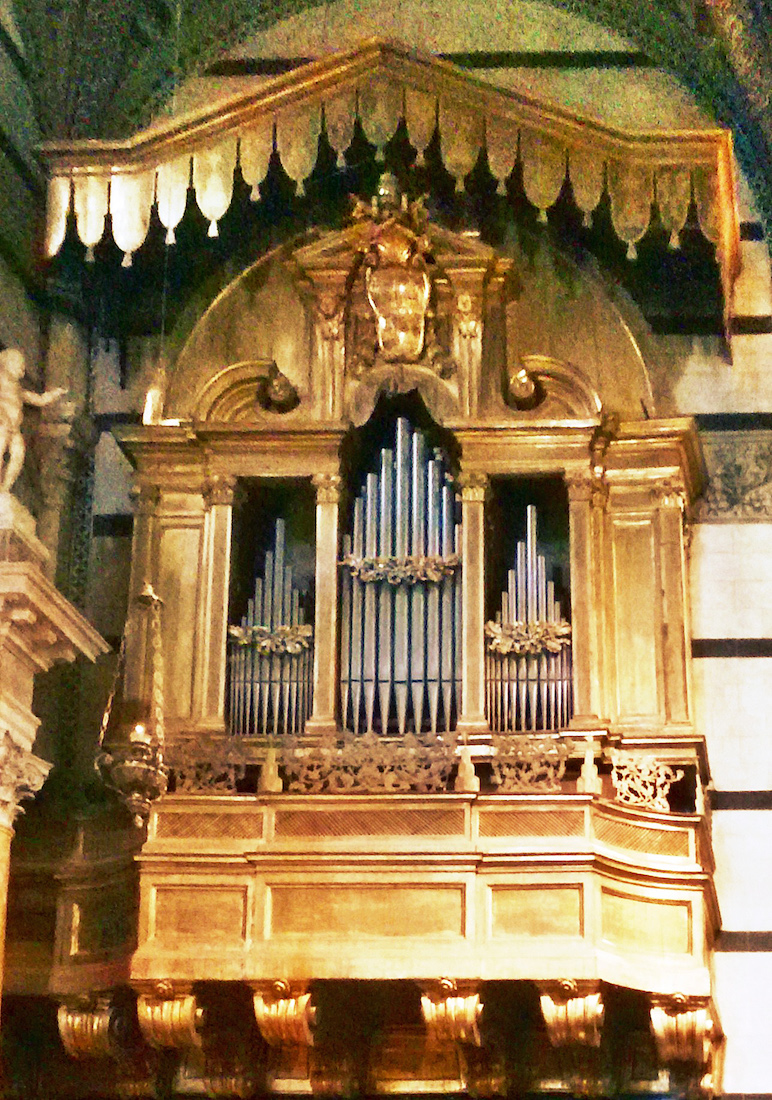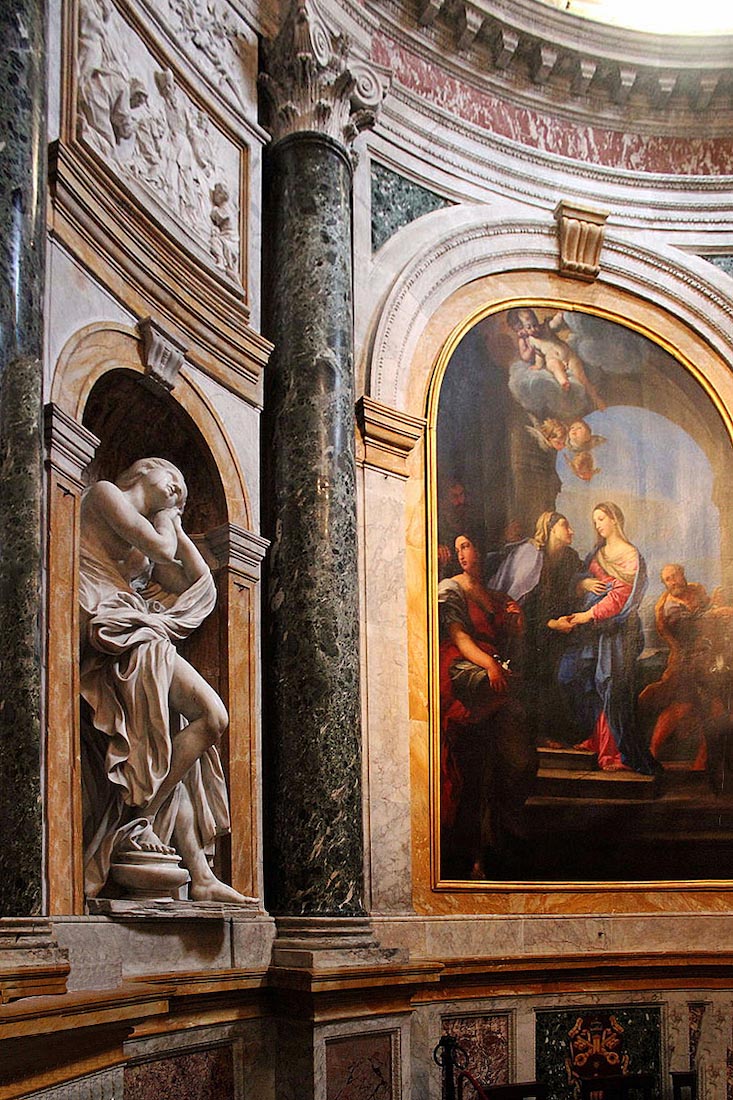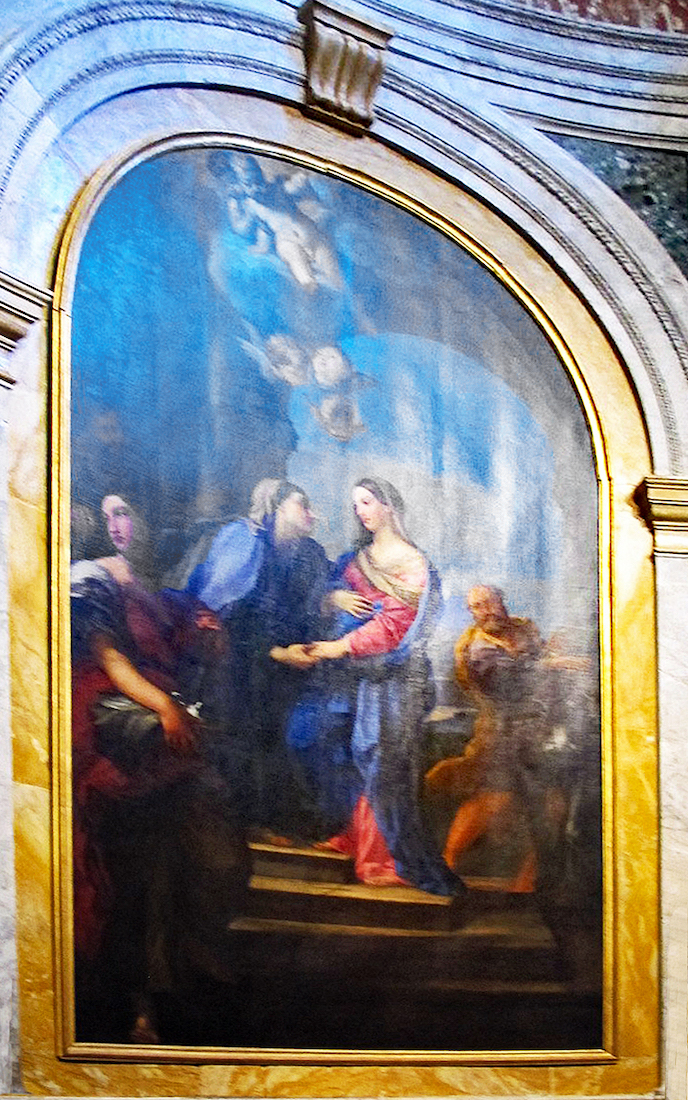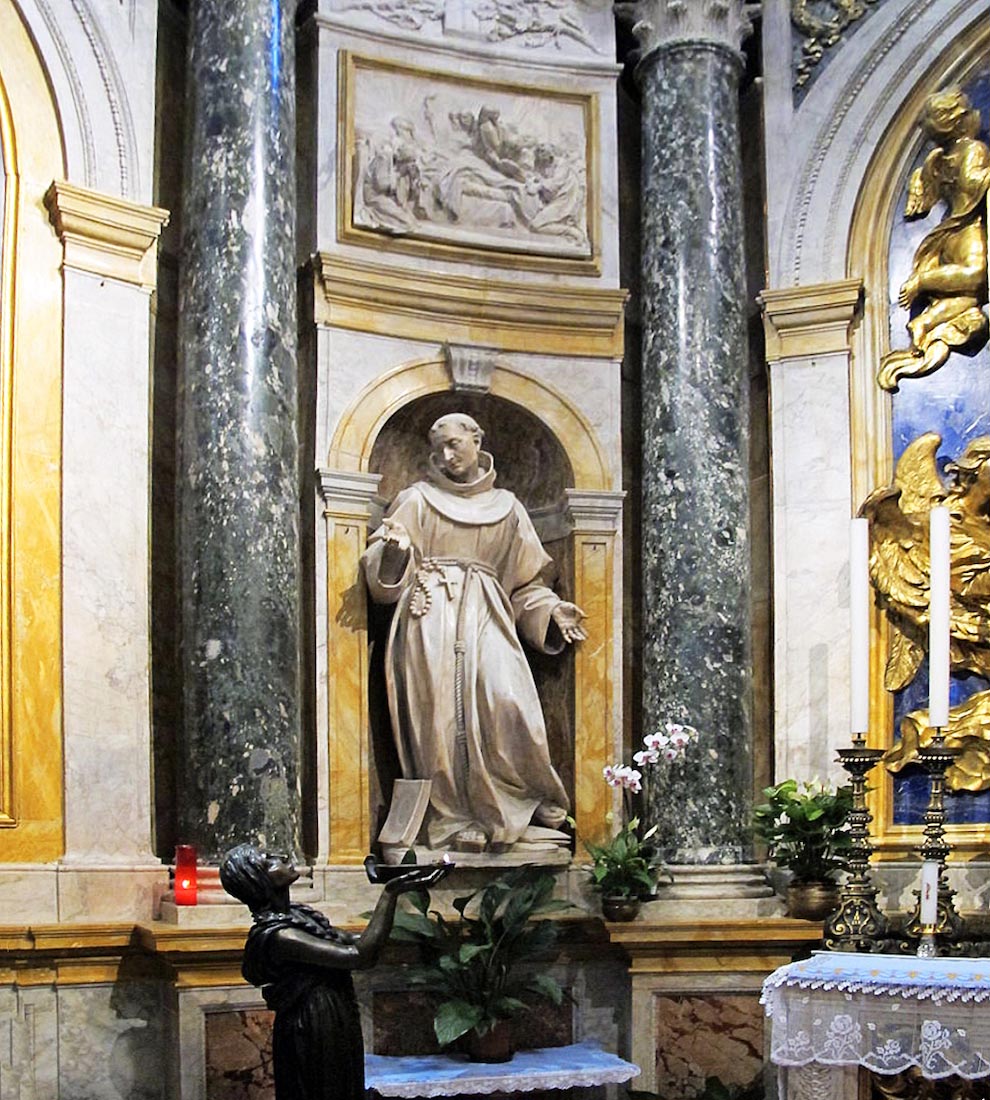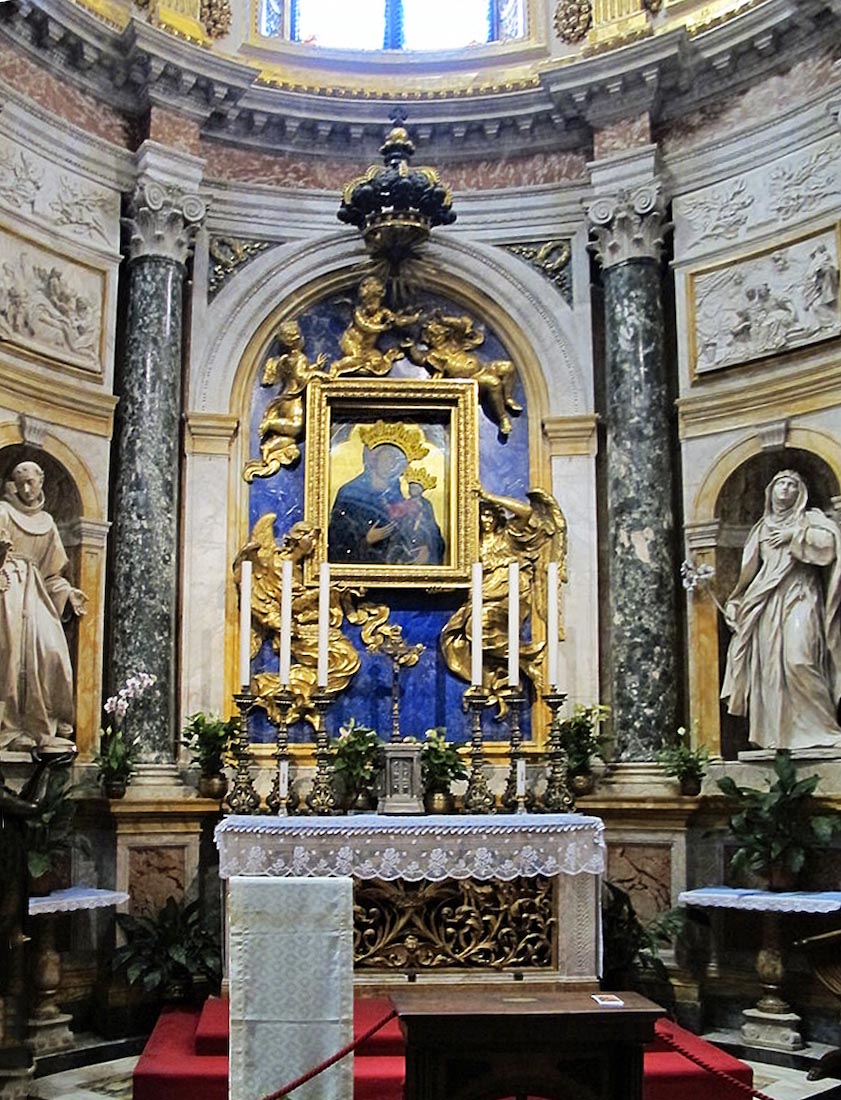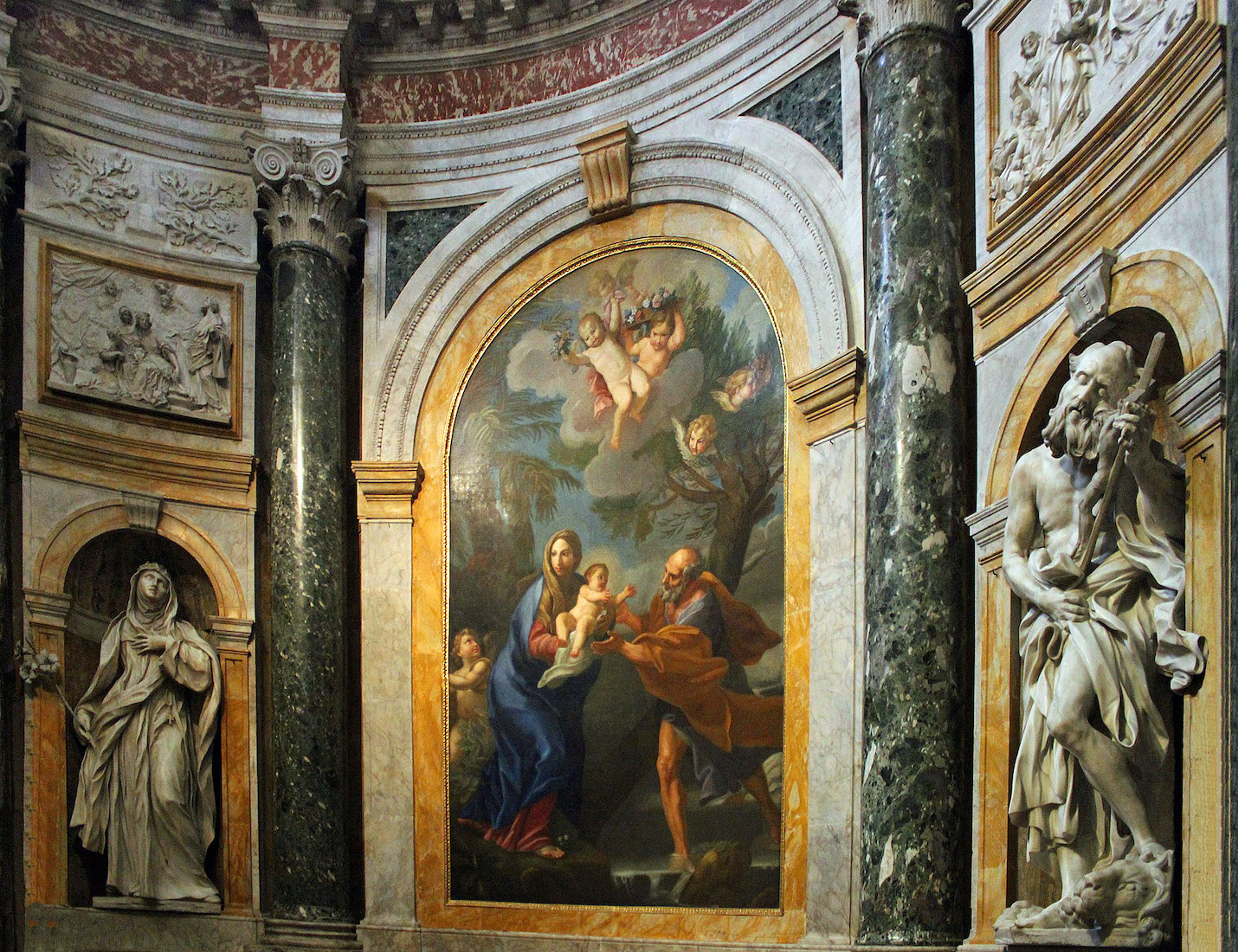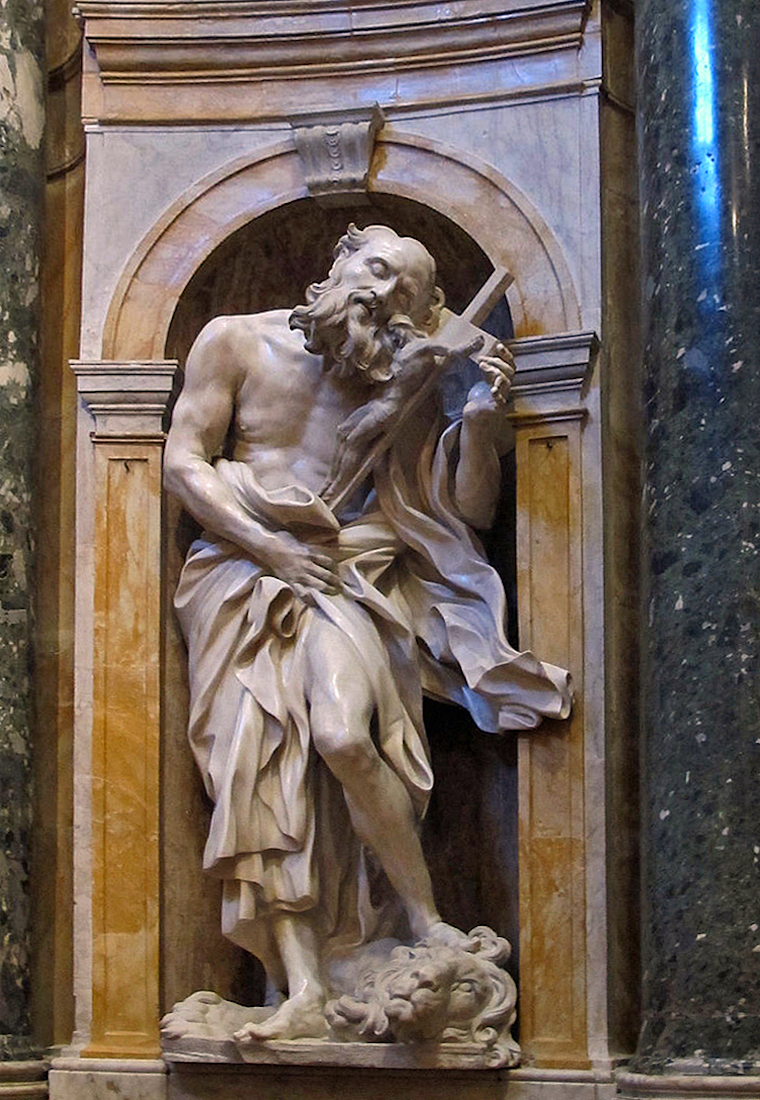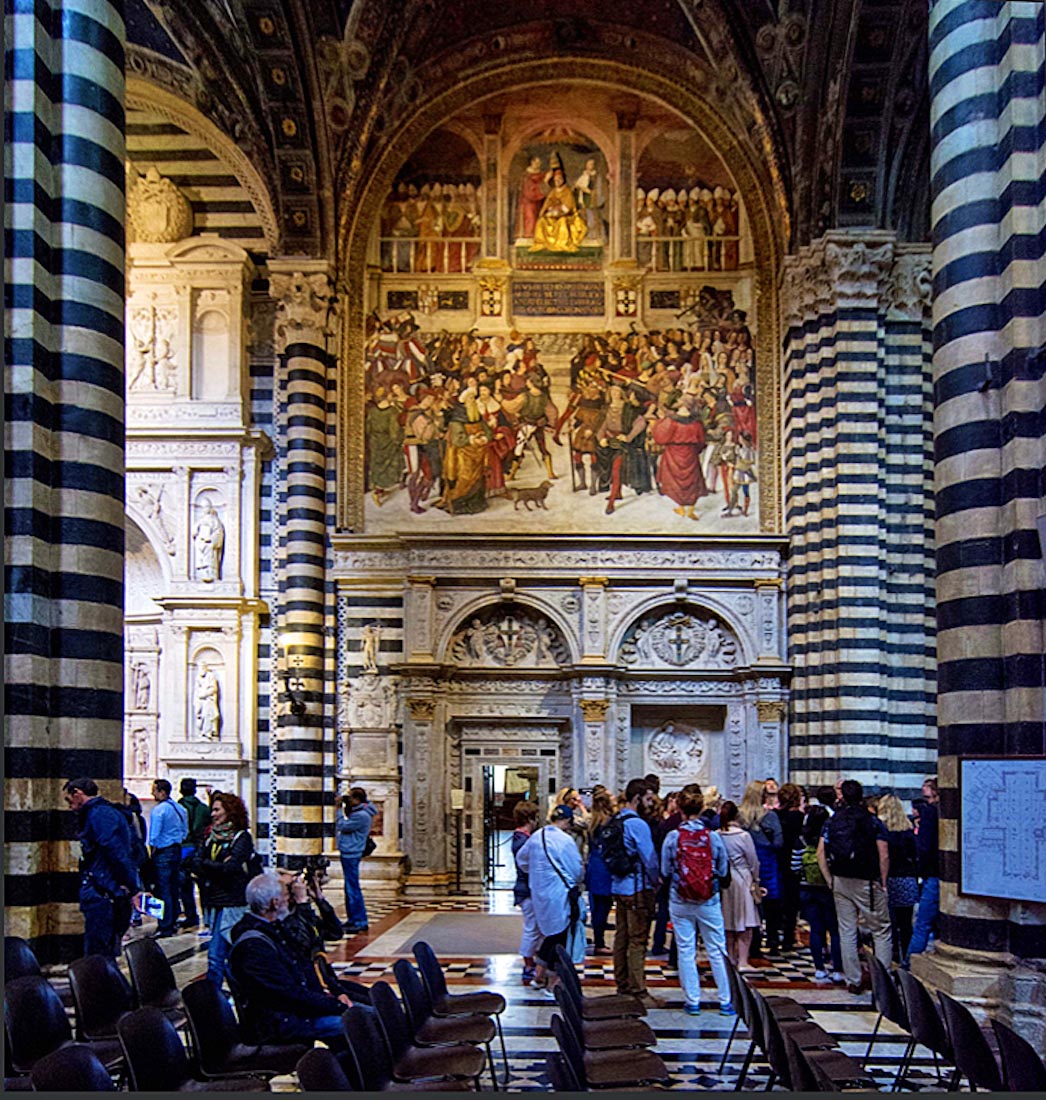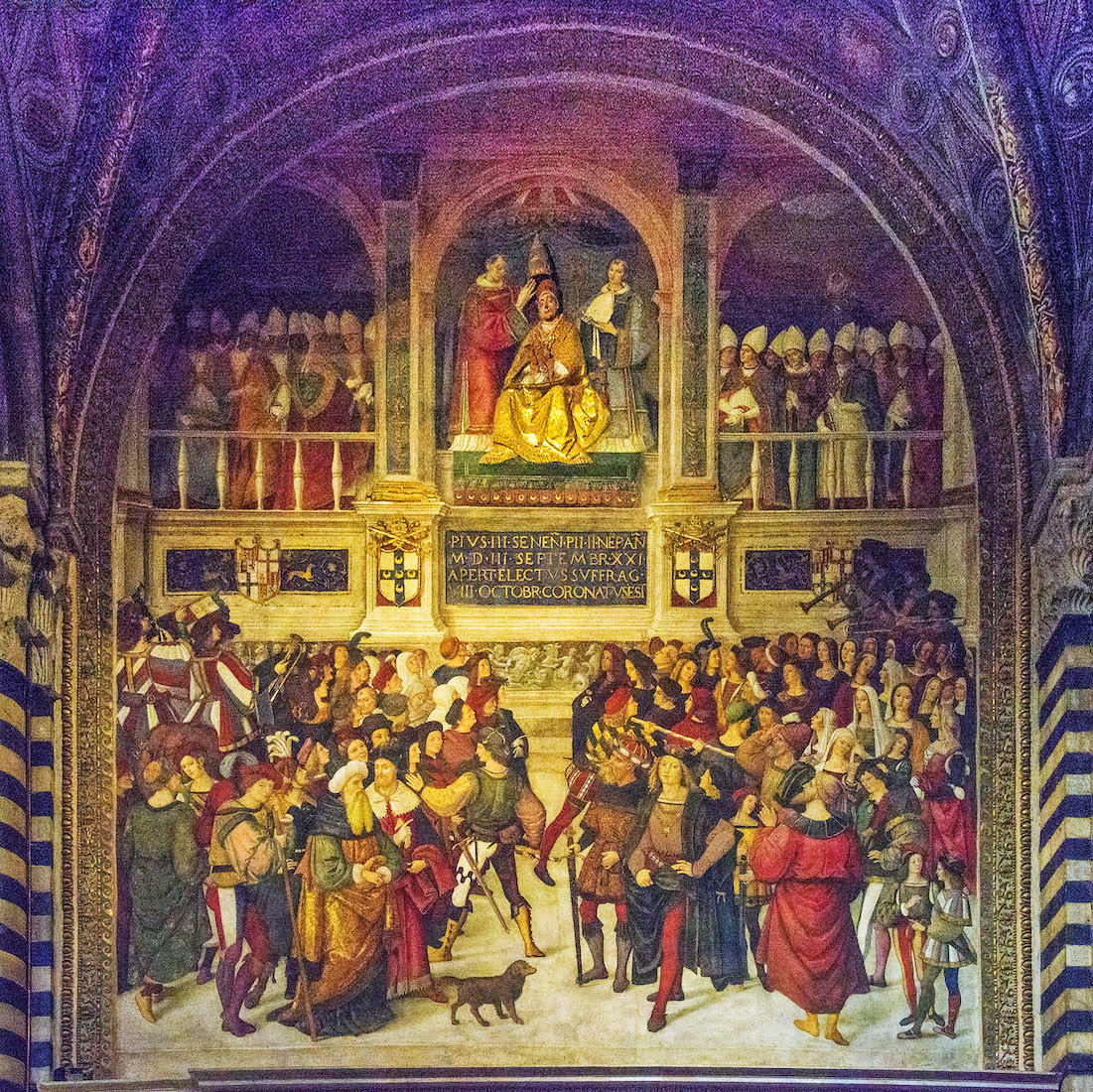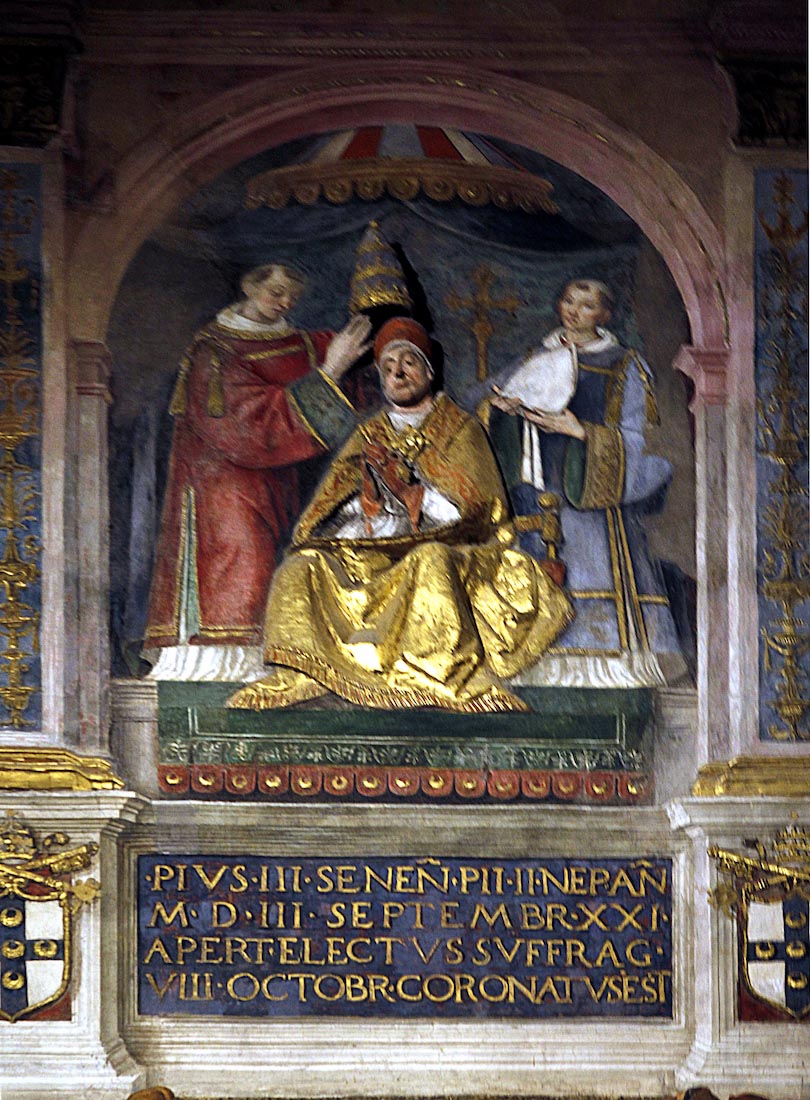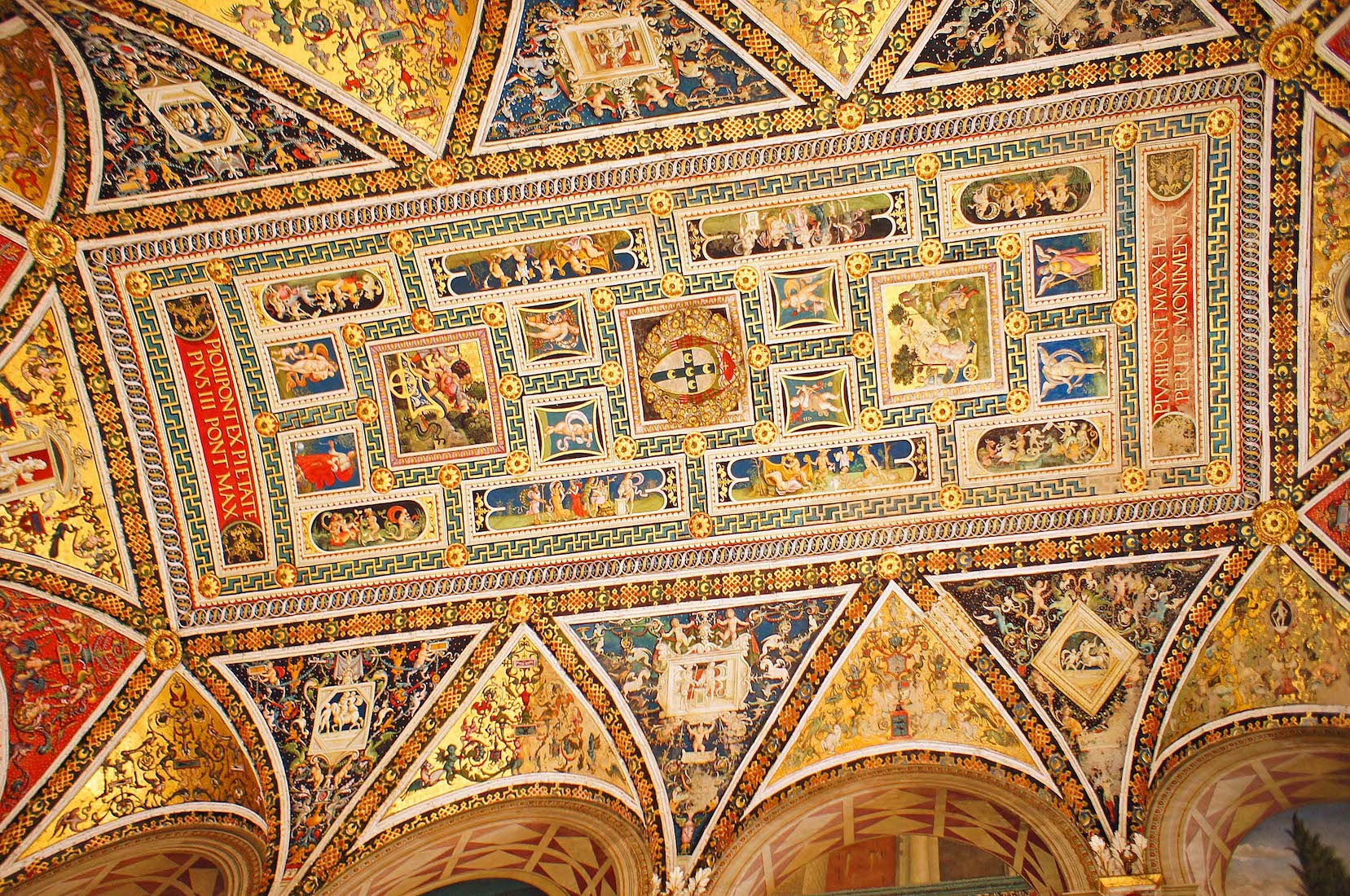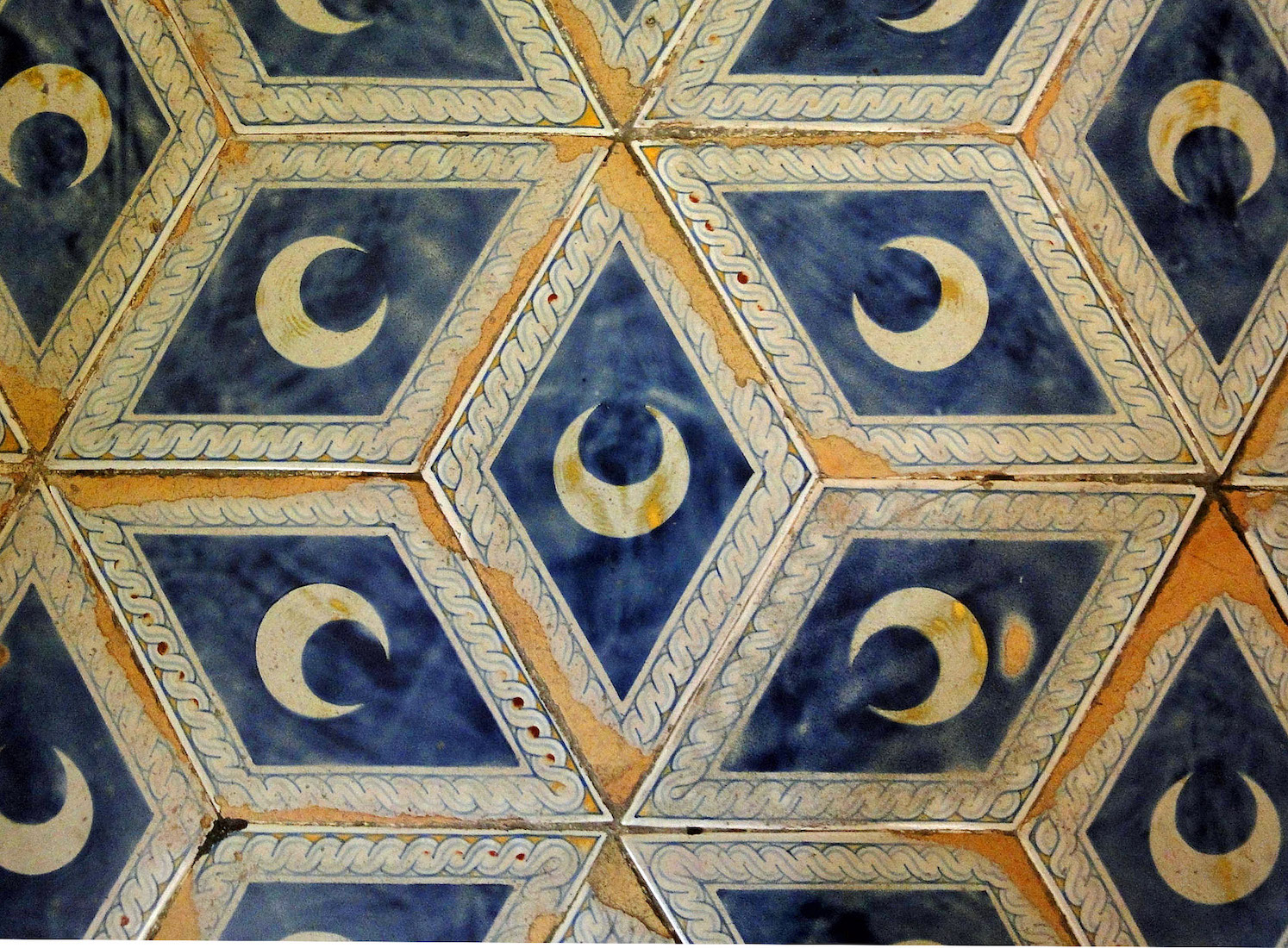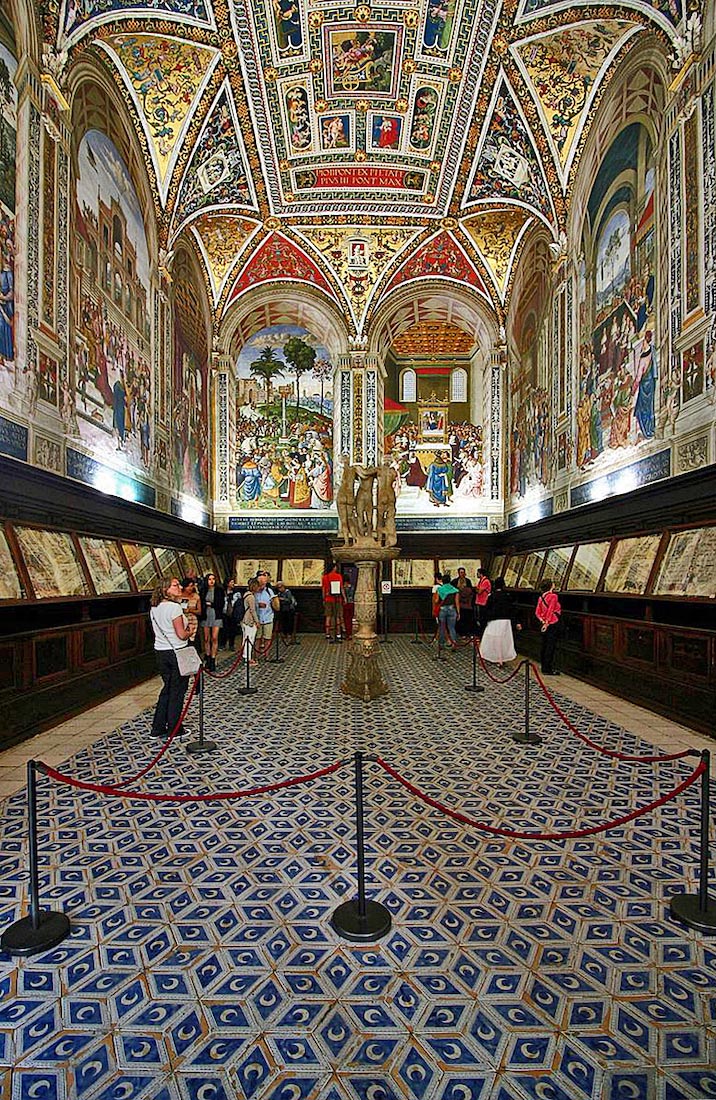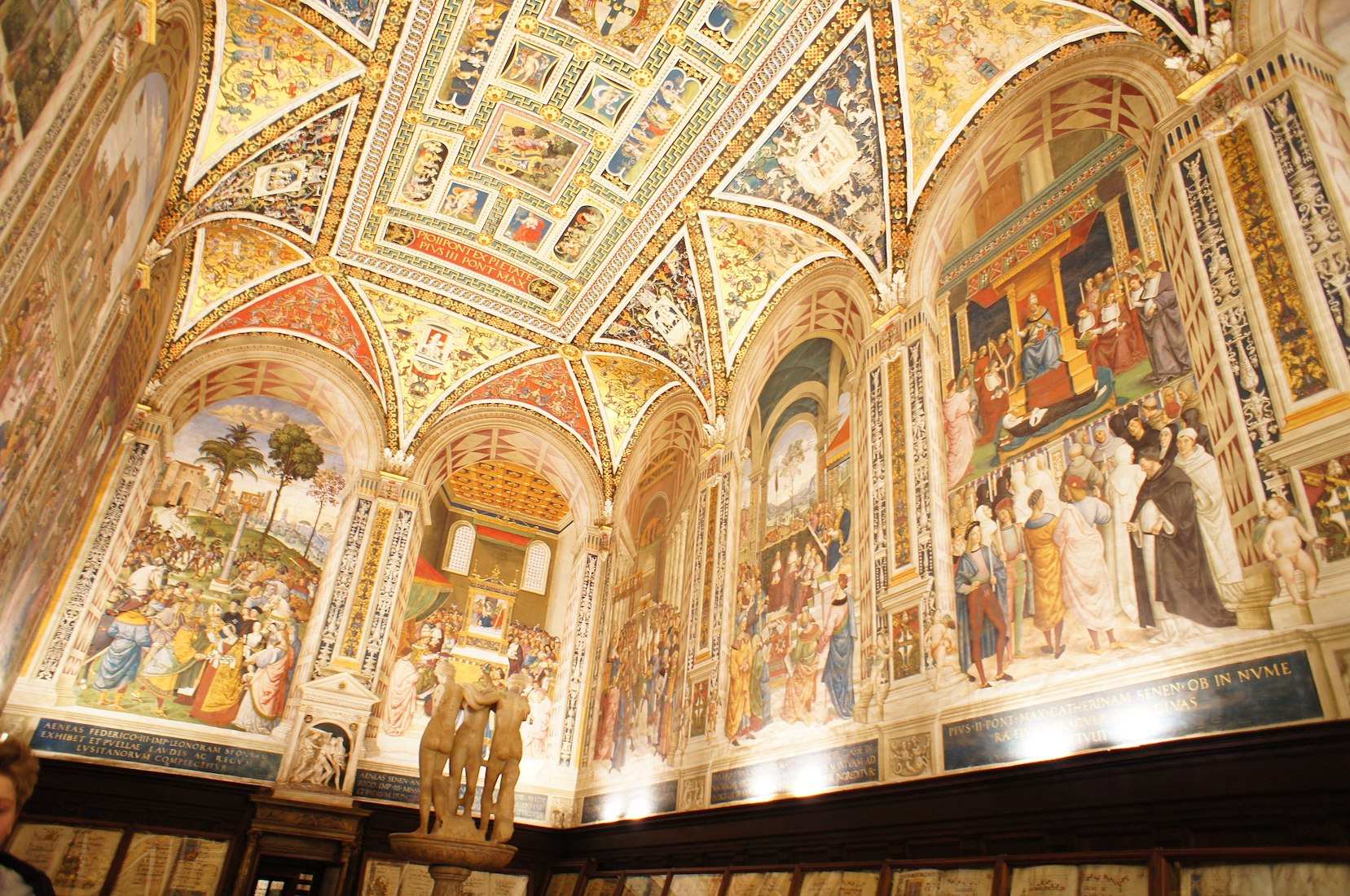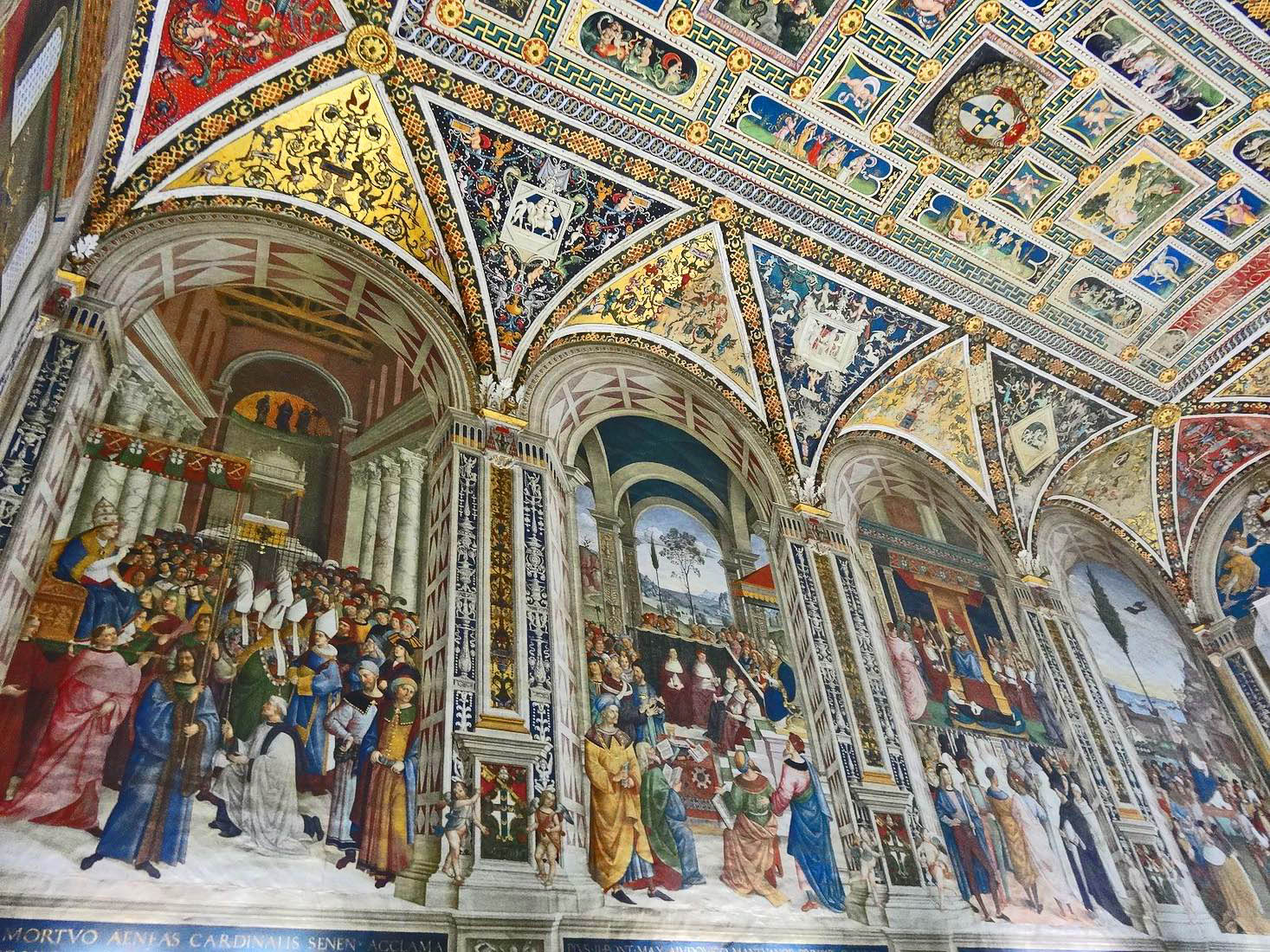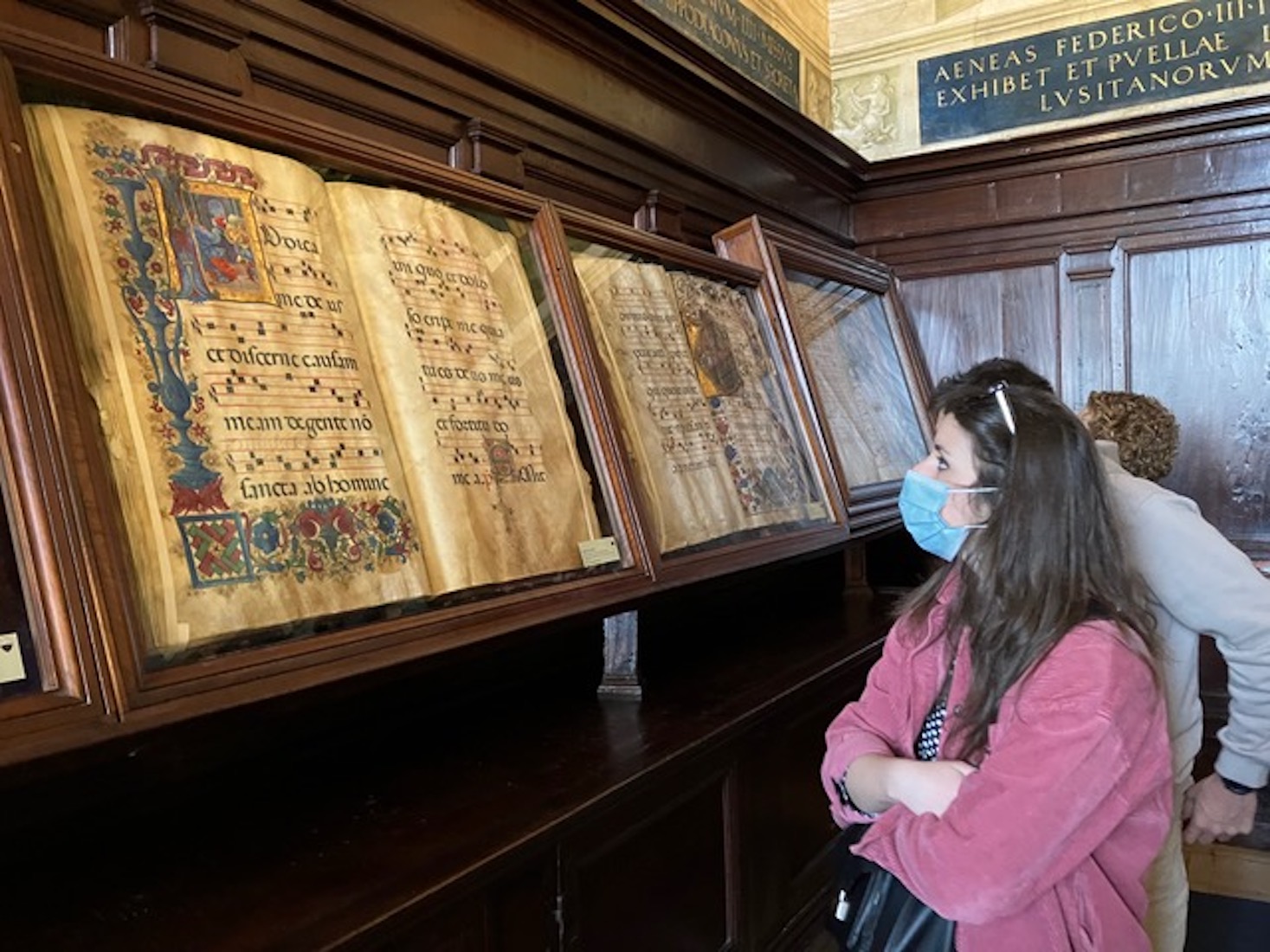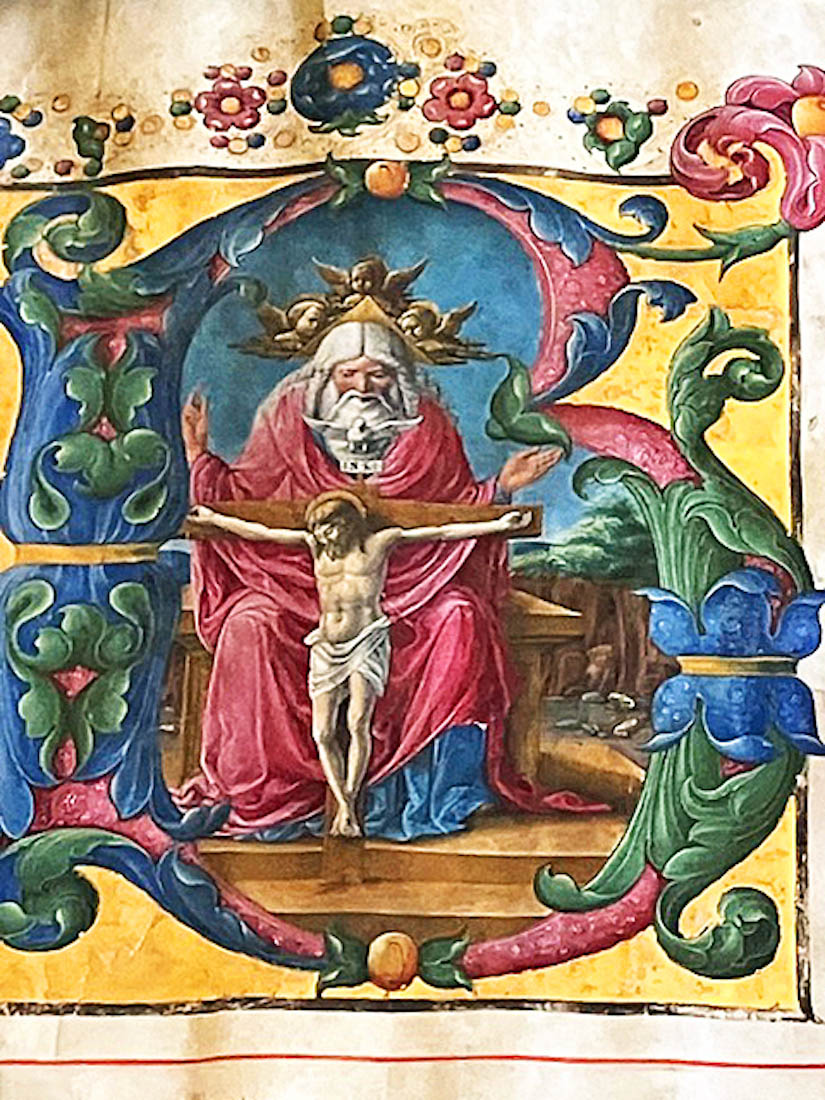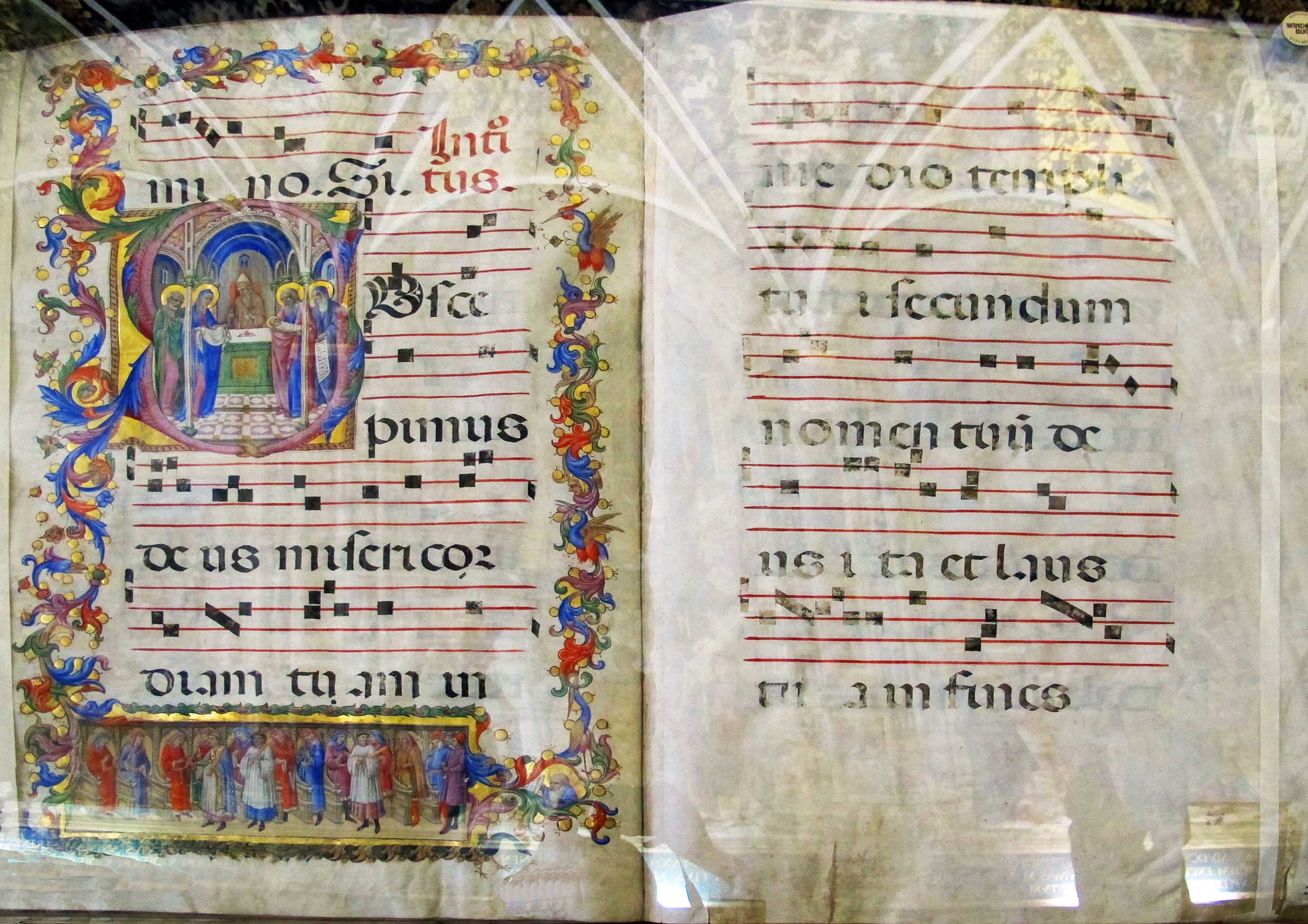C1. TO THE CHIGI CHAPEL GM
We are now going to explore in turn the Chigi Chapel, the Piccolomini Library and the St John the Baptist Chapel. Moving up the South aisle of the nave we come to a large striped wall which makes up part of the base of the bell tower. Incidentally, there is a wall tomb above the entry to the bell tower: the tomb of Tommaso Piccolomini, Bishop of Pienza (a town in the province of Siena). Making our way around this we come to the crossing – with mosaics covered here. We look South to the entrance to the Chigi Chapel. The name comes from Agostino Andrea Chigi (1466 – 1520), who was an Italian banker and patron of the Renaissance, born in Siena. On the wall above the entryway there is a large pipe organ – one of three in the Cathedral. [Photo Credits: Taken from Street View] INDEX
C2. THE AGATI ORGAN WC
Pistoia is a town close to Florence which has a long tradition of organ making. The Agati family played a key part in this tradition: this is one of their organs. [Photo Credit: Pafui PcPifpef]
C3. THE CHIGI CHAPEL FK
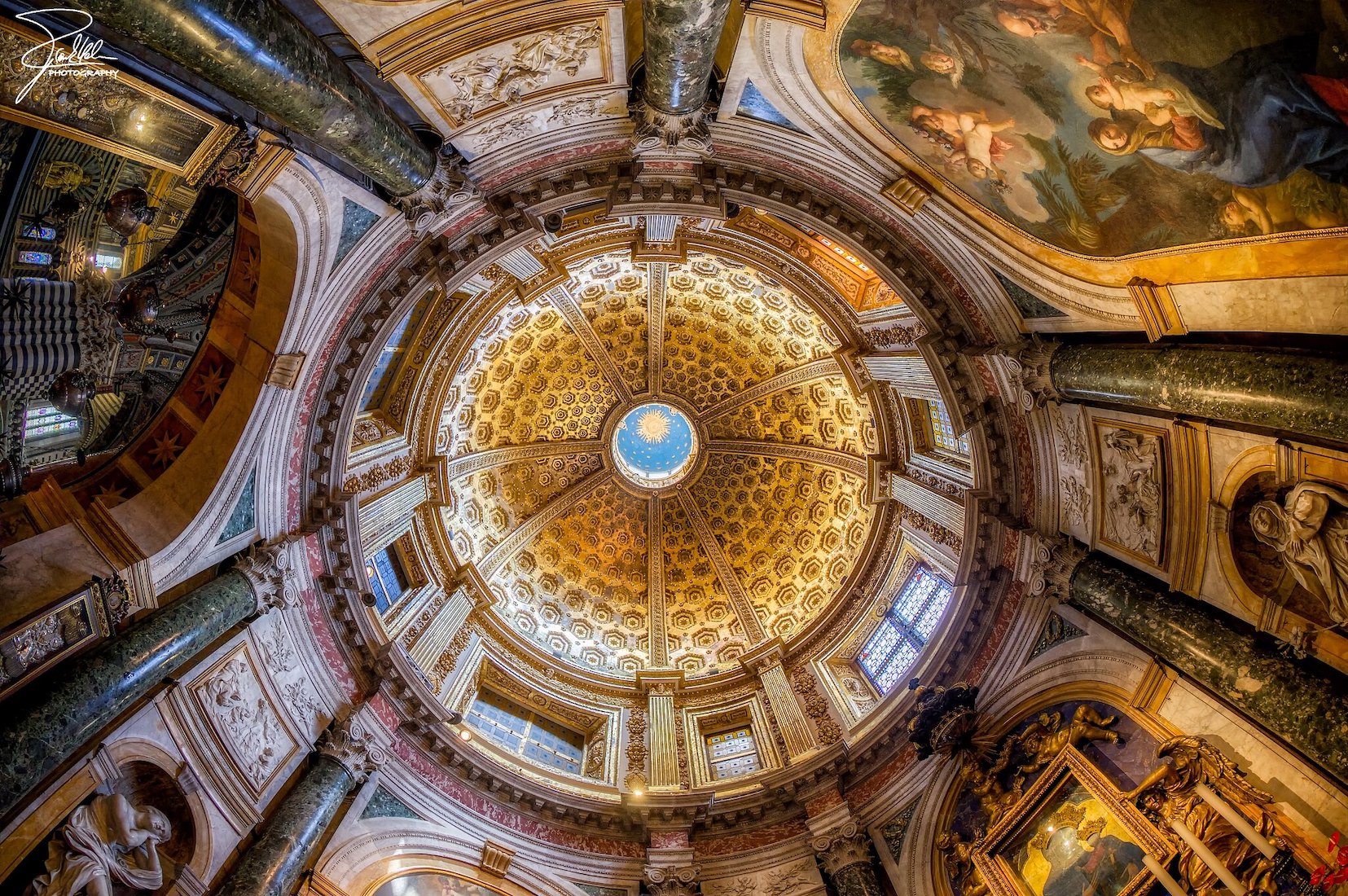
The Chapel is the last, most luxurious sculptural addition to the Duomo, and was commissioned in 1659 by the Sienese Chigi pope Alexander VII. This circular chapel with a gilded dome was built by the German architect Johann Paul Schor to the baroque designs of Gian Lorenzo Bernini, replacing a 15th-century chapel. The Chapel is often described as being round, but it is really octagonal with eight round pillars at the vertices. [Photo Credit: Flickr Frank Kehren]
C4. MARY MAGDALENE FB
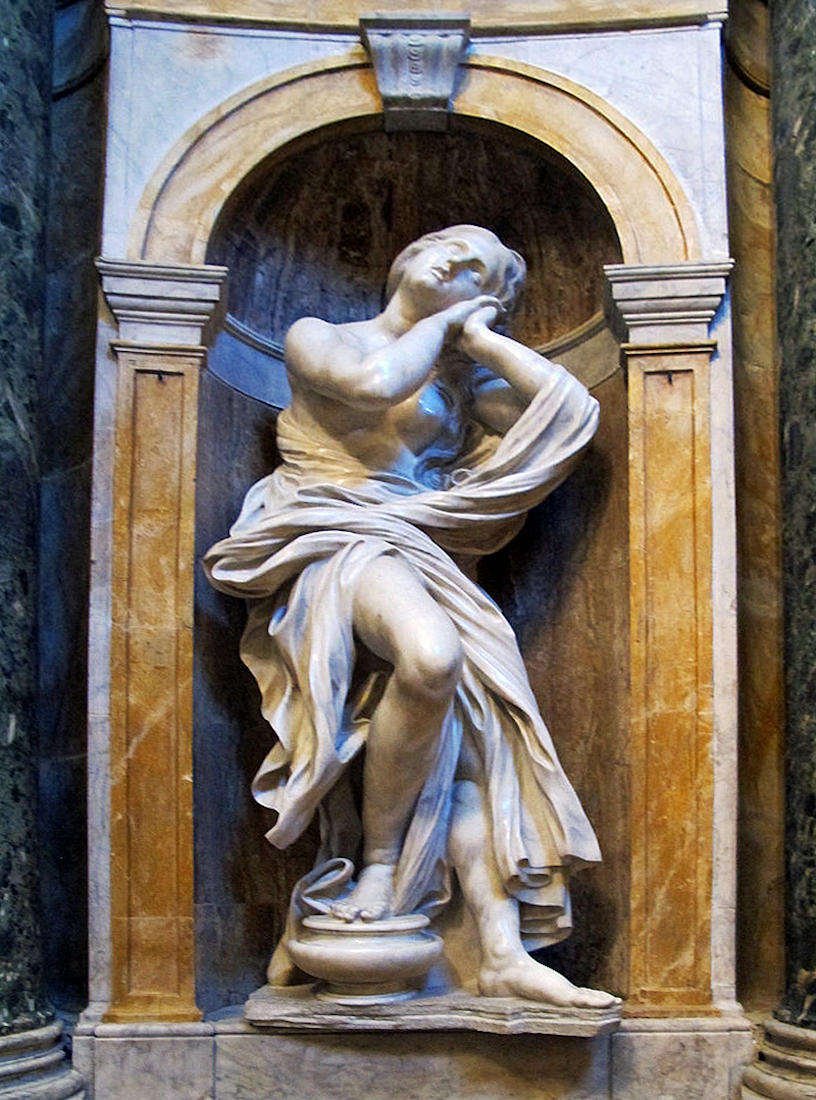
We explore the Chapel standing in the doorway, and investigating from the left. The first statue is St Mary Magdalene, sculpted by Bernini between 1661 and 1663. Mary was a close follower of Jesus who travelled with Jesus and was a witness to his crucifixion and resurrection.
C5. THE VISITATION WC FB
Next to Mary Magdalene is a painting of The Visitation – the time when the expectant Mary visited her cousin Elizabeth, mother to be of John the Baptist. [Photo1 Credit: Miguel HC]
C6. ST BERNADINE FB
Bernardino of Siena (also known in English as Bernardine; 1380 –1444) was an Italian priest and Franciscan missionary. His preaching, his book burnings, and his ‘bonfires of the vanities’ made him famous/infamous during his own lifetime because they were frequently directed against sorcery, gambling, infanticide, witchcraft, homosexuals, Jews, gypsies, usury, etc. Bernardino was later canonised by the Catholic Church as a saint – where he is also referred to as ‘the Apostle of Italy’ – for his efforts to revive the country’s Catholicism during the 15th century.
C7. CHIGI CHAPEL ALTAR FB
We next come to the Chapel altar. Behind is the Madonna del Voto (by a follower of Guido da Siena, 13th century), that even today is much venerated, and receives each year the homages of the local population. On the eve of the battle of Montaperti in 1260, against Florence, the city of Siena had dedicated itself to the Madonna. The victory of the Sienese, against all odds, over the much more numerous Florentines was ascribed to her miraculous protection.
C8. ST CATHERINE OF SIENA FB
Following round past the altar we come to St Catherine. Catherine of Siena (1347 – 1380), a lay member of the Dominican Order, was a mystic, activist, and author who had a great influence on Italian literature and on the Catholic Church. Canonized in 1461, she is also a Doctor of the Church. Catherine of Siena is one of the outstanding figures of medieval Catholicism, by the strong influence she has had in the history of the papacy and her extensive authorship. (She is not to be confused with Catherine of Alexandria.)
C9. NATIVITY WC
Following round past St Catherine we come to a colourful painting of the Nativity. [Photo Credit: Miguel Hermos Cuesta]
C10. ST JEROME FB
Finally, the figure to our right is St Jerome – another sculpture by the Italian artist Bernini. St. Jerome is portrayed embracing the cross of Jesus, almost like a violin. This larger than life size sculpture shows a surprisingly fit Jerome with a friendly lion at his feet. You feel a sense of love exuding from the statue.
C11. ACROSS TO THE PICCOLOMINI LIBRARY LM
Leaving the Chigi Chapel we cross back past the crossing to the North side where there is a doorway surmounted by a large fresco.
C12. LIBRARY ENTRANCE HJD LM
We come to the entrance of the Piccolomini Library. The monumental fresco above the richly carved classical façade depicts the coronation of the library's donor, Francesco Todeschini-Piccolomini, as Pope Pius III. In the lunette above the portal we see the donor's coat of arms as cardinal, in the right-hand lunette the papal coat of arms of his uncle Pius II. [Photo1 Credit: Flickr Hans Jan Dürr; Photo2 Credit: Superchilum]
C13. CORONATION OF PIUS III JLBR
In the fresco, the central figure, Pope Pius III, has been sculpted in relief (presumably in stucco) before being painted and gilded. This adds to the vivid realism and splendor of the scene. Pius, who was in ill health and reigned for less than a month before his death in 1503, was a member of the Piccolomini family of Siena, and many local people were portrayed in the scene. The image was created soon after (likely in 1504).
C14. LIBRARY CEILING WC
We enter the Library and gaze in wonder at the stunning ceiling, painted in blue, red, and gold fanciful grotesque figures. The library is dedicated to one of Siena’s hometown boys, Enea Silvio Piccolomini. He gained prominence by negotiating a truce between Emperor Frederick III and the papal state. In 1458, Enea became Pope Pius II. The Library was built in 1492 by his nephew, a man who became Pope Pius III. Quite the illustrious family! [Photo Credit: Superchilum]
C15. THE LIBRARY FLOOR JF
The ceramic floor of the Library is interesting but nowhere near as flamboyant as the ceiling. The floor is decorated with half moons on a blue background – the emblem of the Piccolomini family. [Photo Credit: Flickr Jim Forest]
C16. VIEW TO THE NORTH FB
In the middle of the room is a copy of the ancient Roman sculptural grouping, The Three Graces, from the 4th to 2nd century BC.
C17. VIEW TO THE SOUTH JLBR
We turn around for this view back towards the entrance. The Library was intended to house valuable manuscripts. They never made it to the Library, but there are now a few samples in glass cases to evoke the original intention. Instead, the Library is famed for its vivid frescos creates by Pinturicchio and his workshop.
C18. THE SOUTHWEST CORNER WC WC
The walls are divided into ten scenes, framed by painted architecture. They represent the stages of Enea’s life — ambassador, bishop, cardinal, pope. [Photo Credits: Photo1 Superechilum; Photo2 Jordiferrer2]
C19. THE MANUSCRIPTS RB
Illuminated manuscripts are hand-written books with painted decoration that generally includes precious metals such as gold or silver. There is a good variety here. [Photo Credit: Ruth Butler (Private Source)]
C20. ILLUMINATED CAPITAL LETTERS RB FB
A feature of medieval manuscript decoration was the ornate chapter letters. Those old monks must have had a lot of time on their hands! [Photo Credit: Photo1 Ruth Butler (Private Source)]


